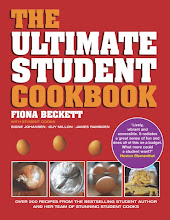
Admittedly not a classic Scandinavian ingredient but passionfruit always reminds me of this heavenly tropical soda my Dad brought back from Sweden when I was younger. Amazing stuff, the Swedes do know something about making soda, although it's probably contraband (Norwegians don't like a lot of imports from abroad, even if it's their next-door neighbour). If I tasted this tropical lusciousness now I might be less enamoured by its walloping sacharineness, not to mention the plethora of 'E' numbers and preservatives. At any rate, the smell and taste of
passionfruit pulp is an absolute joy and I don't bake nearly enough with this curious, wrinkly fruit. So, on the eve of my flatmate Sophie's birthday out came the baking bibles and I scoured through to find something worthy of her impending celebrations, et voila! a lovely citrussy sponge adapted from the Leiths Baking Bible with a passionfruit cream cheese icing. I added some ground almonds to the sponge for a bit of texture and moistness, and also chucked in frozen blueberries to the mix which went well with the lime zest, but was somewhat over
whelmed by the exquisite passionfruit icing. Whatever, it was still sheer passionfruit bliss, eat it and weep.
- 150g softened butter
- 150g caster sugar
- grated zest of 1 lime
- 3 medium eggs
- 130g self-raising flour
- 1/2 tsp baking powder
- 70g ground almonds
- pinch salt
- 150g frozen blueberries (optional) or raspberries

Icing Ingredients
- 150g Philadelphia Cream Cheese - no cheating, it has to be the full-fat variety
- 100g softened butter
- 60g icing sugar (this can be varied by 15g, depending on the tartness of the passionfruit)
- 2 passionfruit - 1 for the icing, 1 for decorating
- 1/2 tsp vanilla extract
Preheat oven to 190ºC. Lightly oil a round 20cm cake tin and set aside.
In a medium bowl, cream the softened butter with an electric mixer, then add the sugar, beat again until pale and fluffy before adding the lime zest. Add the eggs individually, beating with the mixer after each addition, and then finally add the ground almonds, and flour, folding through 6-8 times with a large metal spoon. Add your blueberries or raspberries at this stage and give the mix a few more folds with the spoon before turning out into the cake tin.
Bake on the central shelf in the oven for 45 minutes. This is quite a moist cake so it will take a little longer to bake through, if it starts to scorch, turn the heat down to 170ºC.
When the cake is baked, allow to cool completely before preparing the icing: using an electric whisk, soften the Philadelphia for a minute, then add the soft butter and mix thoroughly. Add your vanilla extract and icing sugar, and finally take the pulp of 1 passionfruit, including the spawn-like seeds, and fold this in to the icing with as spoon. Using a spatula, smooth the icing over the now-cooled cake and then using a teaspoon place dollops of passionfruit pulp & seeds all over the icing to create a polka dot effect! As it's rather warm and sultry in London I would advise keeping the cake in your fridge to prevent the icing from going rancid, it keeps rather well for a day or two...
























